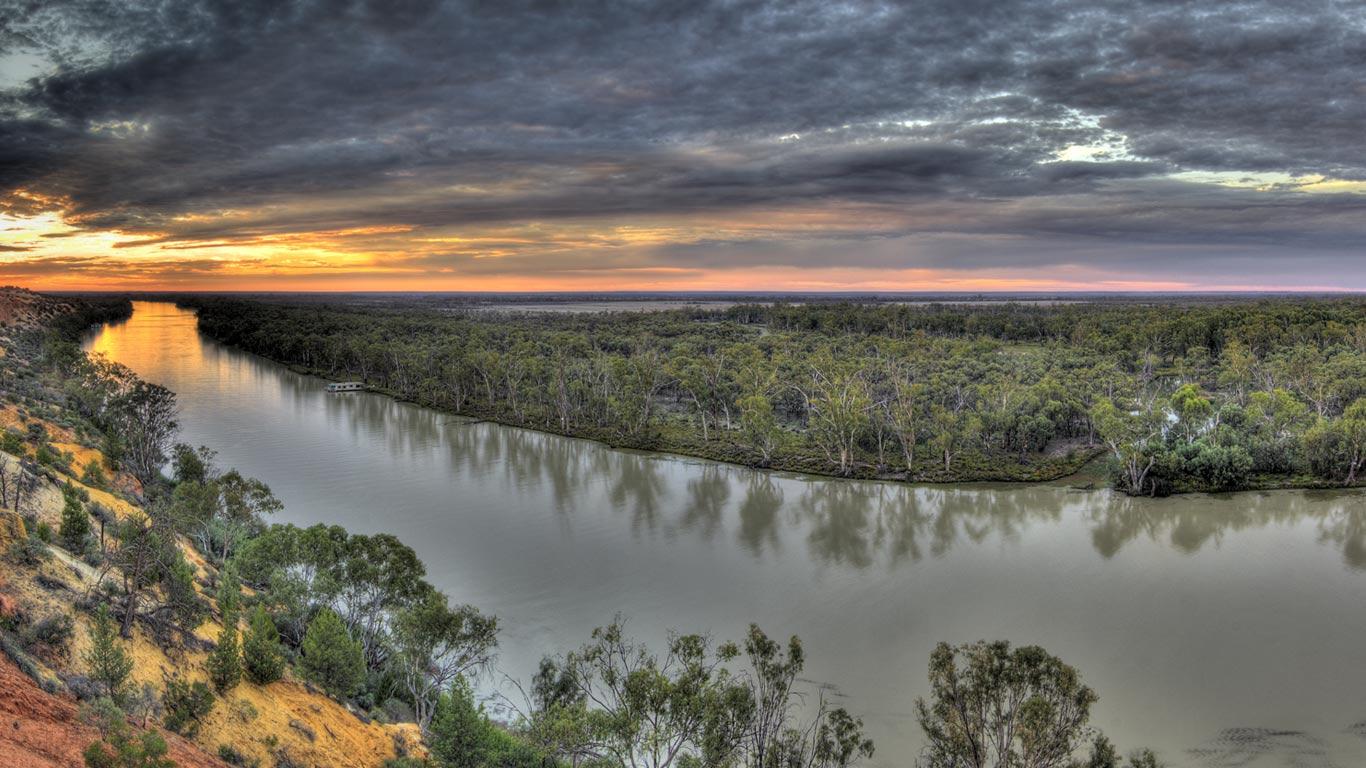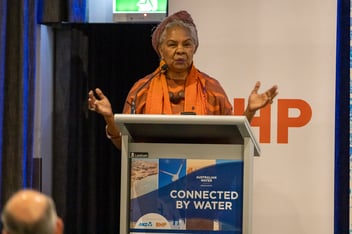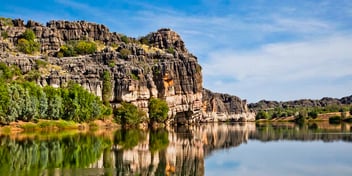Dialogue-based research combines knowledges for water justice

In a remarkable collaboration between Indigenous custodians, artists, economists and water scientists, a unique dialogue-based research project has produced a narrative of the Baaka (NSW) and the Martuwarra (Western Australia) rivers in support of water justice.
Published in July, ‘A tale of two rivers – Baaka and Martuwarra, Australia: Shared voices and art towards water justice’ presents a narrative connecting Indigenous Knowledge, art and biophysical features to provide new ways of understanding the two river systems.
The narrative is co-authored by Indigenous knowledge holders – Professor Anne Poelina, Badger Bates (and artist), Glenn Loughrey (and artist), Professor Virginia Marshall and Hozaus Claire (and artist) – with other artists Ruby Davis and Dan Schultz as well as a team of water researchers from the Australian National University (ANU) Water Justice Hub.
ANU’s Water Justice Hub Convenor and co-author Professor Quentin Grafton said the narrative is a shared response to the impacts of over extraction of water on the Baaka, and concerns that the Martuwarra will face the same outcome.
“In some sense, the two rivers chose themselves for this narrative. If you take the perspective of the Indigenous co-authors of this work, these rivers are living waters and are seeking the sort of care and custodianship that they once had for a long time,” he said.
“There has been a dialogue between the Baaka in the Murray-Darling Basin and the Martuwarra in the Kimberly before we began this process. This dialogue was already underway, and was initially explored through the work of Badger Bates and Sarah Martin from the Baaka and Anne Poelina from the Martuwarra.
“What we did at the Institute for Water Justice was continue that dialogue in a different way.
“The process was about having people with different backgrounds and experiences and Country come together in different ways to describe what these two rivers mean, what they are and what journeys, we as people, need to take to care for these two rivers.”
Through the dialogue process, five action pathways, or journeys, linked closely with Indigenous Knowledge and Law, have been identified to guide water decision making towards water justice.
Emergent process
Professor Grafton said an important part of the work was the dialogue process itself – allowing the narrative to emerge through dialogue, after first ensuring diversity and trust among those included in the dialogue.
“We had the dialogue between the two rivers in mind, but how it worked out was an emergent process. It was not defined in advance. We wanted to bring in different ways of describing and understanding,” he said.
“My background as an academic is very much about using words and models. And while that work can be useful, it is inadequate to convey the whole sets of knowledge and understandings available about these two rivers.”
Professor Grafton said that including art in the dialogue was very deliberate, with artists providing their art as a way of describing the two rivers in ways that cannot be done by words alone.
“We reached out to our friend, colleague and artist, Wiradjuri man Glenn Loughrey. We also had a PhD student in the team who is also an artist, Dan Schultz. And, of course, we had the world-famous artist Badger Bates,” he said.
“But there were other artists there as well, including Ruby Davis. From the Kimberly, Anne Poelina very kindly brought the artist Hozaus Claire to work with us.”
After meeting on the Baaka in 2021, again in Broome in 2022 and after speaking with the Martuwarra Council, the co-authors decided to bring together the ideas that had materialised after 18 months of dialogue.
“We brought all of the work we had been doing together under the title ‘shared voices and art towards water justice’,” he said.
“We are genuinely pleased with how the project has turned out. But this is really all about outcomes. It’s about ways of moving forward towards water justice for these two rivers.”
Five Journeys
The narrative outlines five journeys or pathways towards water justice, all of which are informed by Indigenous Knowledge and Law, Professor Grafton said.
“The ideas involved in these journeys are long standing. They are ideas that have been practiced on this continent for thousands of years. I do not speak on behalf of any of the co-authors when summarising the ideas outlined in the narrative,” he said.
“The five pathways are not meant to be exhaustive, either. These are the priority pathways identified by the group when we met in Broome in 2022, but there are many more.”
Professor Grafton said deep listening has been highlighted as a key practice moving forward.
“Deep listening is the idea that spending time on Country and listening to Country to understand what it is telling you. This practice has a long history on this continent,” he said.
“It’s important because Elders are telling us that these two rivers are speaking to us. And we have to listen to them. So deep listening is very important.”
Professor Grafton said the Martuwarra Council also highlighted the need to incorporate First Law: “There is law going back thousands of years in terms of responsibilities in relation to Country. This law takes precedence over anything else. There are ways of acting as custodians, which is very important and to make sure the First Law is respected”.
“Connected is the idea of intergenerational care from a circular time perspective, or EveryWhen,” he said.
Grafton said Elder Elsie Jones’ description of EveryWhen in the narrative is a good summary of this idea: ‘We do not exist only now, we are part of our past and part of our future and we are linked to our land’.
“This is a key concept in terms of understanding how we need to engage with the rivers and indeed with Country,” he said.
The other two journeys or pathways proposed in the narrative are a more expansive understanding of water rights for Indigenous Peoples and the need to bring together different knowledges.
“The ability to act as custodians for the Living Waters requires Indigenous water rights. While water entitlements are certainly a part of water rights, water justice is not limited to entitlements for First Nations Peoples; it’s about the right to exercise responsibility, authority for decision-making and custodianship in all sorts of dimensions,” Professor Grafton said.
“The final pathway is the view of braiding or bringing together different knowledges. And this was certainly the intent with what we were trying to achieve with this research – to bring these knowledges together to produce an understanding that you wouldn’t otherwise get.”
Story for water justice
Professor Graton said dialogue, storytelling and yarning are hugely important to the process of working toward water justice for the two rivers and for their custodians.
“Water justice is not an outcome, it’s a process. Water justice is very much about understanding causes and effects, but then also about engaging. Storytelling, or yarning, is very much part of that,” he said.
“Storytelling is giving insights in terms of how we got to where we are and how we move to some other point of water justice. But it’s also about listening to the story being told by the rivers themselves.
“This is very important, as the Baaka has a story to tell – it’s not a happy tale. Badger sums it up in words and art, but then we also have other evidence provided in terms of what has happened to the Baaka. There is degradation in water quality, declining stream flows, and negative effects on ecosystem services.
“And this story is being communicated between the two rivers. The message is: let’s not go down the path forced on the Baaka, let’s take a different path for the Martuwarra.”



